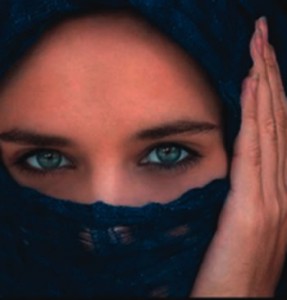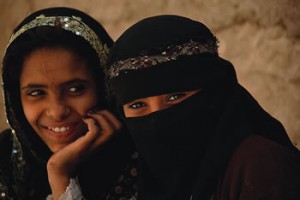Lifting the Veil
by Jane Kamerling, and Fred Gustafson, Members of the Chicago Society of Jungian Analysts 
The veil has emerged in the 21st century as an international symbol that holds a variety of meanings. The veil can be understood as merely the customary dress of Arab women, a religious expression, or a political statement. For some women donning the veil represents male dominance enforced by the threat of beatings or death. For others, the veil signifies self-determination and independence in reaction to the threat of western ideology impacting Islamic culture.
The veil powerfully holds the polarity of attitudes and beliefs and invites the projections of the psychological complexes in both western and Islamic societies. These negative shadow projections fuel external and internal conflict between and within each culture. The veil is not just a female garment to hide, protect or humble Muslim women, but the curtain behind which resides the feminine principle, repressed in both east and west. Beneath the veil resides the unconsciousness of both cultures that become manifested in the politics of today.
The impact of 9/11 awakened the North American culture and brought a new awareness of its vulnerability. This event has challenged America’s perspective of itself, its culture and its country, within the context of world conflict. The western response to the tragic collapse of the World Trade Center and the Pentagon was filled with fear and revenge as the American sense of safety and security dissolved. The American culture was deeply traumatized, requiring defenses from deep within the cultural psyche to protect its profound wound. Most Americans knew little of Al Qaeda or why they were assaulted. There was little inquiry about its contribution to the conflict but, instead, with the label of enemy projected evil, primitive and inferior onto the “other”.
The Islamic culture, also, felt defeated and threatened after years of war between tribes and countries, western colonialization and exploitation and the reality of globalization that threatens the stability of traditional Islamic society. Islamist figures have arisen as the archetypal defense of the collective wounded spirit. Imaged by Osama Bin Laden, the Mujahideen, Kohemini, Arafat as well as the multitude of other terrorist organizations, the characteristics of avenger and restorer become incarnated.
 The cultural memory of the lost Caliphate, world dominance and superior Islamic civilizations keep the longing to recreate the glory of a past time that compensates for the powerlessness felt today. The west becomes engaged as the rival defender of justice, freedom for all and God. Islamists protect the continuity and survival of Islam. The dynamics of cultural complexes are unleashed creating violence and destruction. All this hides behind the veil of righteousness and absolute truth.
The cultural memory of the lost Caliphate, world dominance and superior Islamic civilizations keep the longing to recreate the glory of a past time that compensates for the powerlessness felt today. The west becomes engaged as the rival defender of justice, freedom for all and God. Islamists protect the continuity and survival of Islam. The dynamics of cultural complexes are unleashed creating violence and destruction. All this hides behind the veil of righteousness and absolute truth.
The solution to violence and fundamentalism will be found by trying to explore the history which has formulated the Islamic and American complexes and their interaction. Each side needs to tell its story. What is suggested here is that when the stories stop, violence and fundamentalism begin. We get stuck where our story can no longer continue. If we can restart our story and listen to the story of our adversary, we gain a better understanding of the violence in our own time and one that offers a possible path for its solution. The healing is in the reclaiming of the feminine principle, bringing wholeness to the world soul. (slightly abridged)
 Entries(RSS)
Entries(RSS)